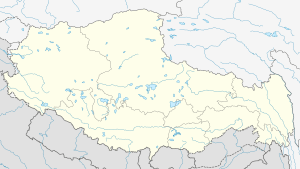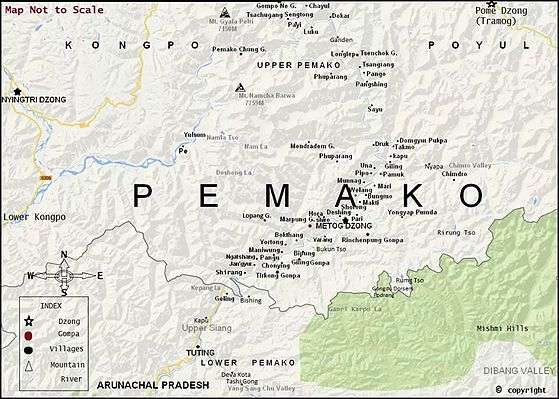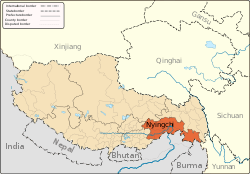Mêdog County
| Mêdog County 墨脱县 • མེ་ཏོག་རྫོང་། | |
|---|---|
| County | |
.png) Location of Mêdog County (yellow) within Nyingchi City (yellow) and the Tibet A.R. | |
 Mêdog County Location in Tibet | |
| Coordinates: 29°29′N 95°30′E / 29.483°N 95.500°E | |
| Country | People's Republic of China |
| Region | Tibet |
| Prefecture-level city | Nyingchi |
| County seat | Metog |
| Area | |
| • Total | 34,000 km2 (13,000 sq mi) |
| Elevation | 2,500 m (8,200 ft) |
| Population (2010 Census) | |
| • Total | 10,963[1] |
| Time zone | UTC+8 (China Standard) |
Mêdog, Metok, or Motuo County (Tibetan: མེ་ཏོག་རྫོང་,, Wylie: Metog Rdzong ; simplified Chinese: 墨脱县; traditional Chinese: 墨脫縣; pinyin: Mòtuō Xiàn), also known as the Pemako (Tibetan: པདྨ་བཀོད་, Wylie: pad ma bkod, THL: Pémakö, ZYPY: Bämagö "Lotus Array", Chinese: 白马岗), is a county as well as a traditional region of the Nyingtri Prefecture in the Tibet Autonomous Region of the People's Republic of China (PRC). It further stretches across McMahon Line into neighboring Upper Siang district of Arunachal Pradesh; today one-third of historical Pemako – Lower Pemako – lies in Upper Siang district, which is claimed by the PRC.
Geography
Medog County is located in the southeast of the Tibet Autonomous Region and at the lower branch of Yarlung Tsangpo River. Medog County covers an area of 30,553 km2 (11,797 sq mi).
The average altitude of the county is 1,200 m (3,900 ft) above sea level.་Metok county is also called Pemakö. Pemakö is located in the average altitude ranging from 1,000–3,500 metres (3,300–11,500 ft) above seas level. It covers 30,000 square kilometres (12,000 sq mi) stretching from south of Kongpo and Powo (Bomê) through the lower Yarlung Tsangpo River into Arunachal Pradesh, surrounded by high mountains: the tallest is Namcha Barwa at 7,782 metres (25,531 ft)). Pemako has lush vegetation and many species of wild animals. Unlike other parts of Tibet, it receives plenty of rain, and has diverse biomes: there are subalpine coniferous forests in the north and temperate coniferous forest in the south in the low-lying area of the Yarlung Tsangpo gorges.
River Tsangpo (Tsangchu) which originates from Lake Manasarovar in Western Tibet flows through 1,500 km (930 mi) eastward when it reaches Mt Namcha Barwa, its bend making a U shape turn to penetrate into lower Himalayan ranges, thus carving one of the deepest Canyon in the world. Water dropping above 3,000 meters near Phe, about 300 metres at the end of the gorge. The river is called Tsangchu a famous river in Pemakoe, like kyichu in lhasa.
Climate and wildlife
Medog has a favourable climate caused by the relatively low elevations in parts of the county (down to just 600 m above sea level in the Yarlung Zangbo river valley) and by the South Asian monsoon, which brings moisture from the Indian Ocean. The area is lush and covered with trees and includes the Medog National Animal and Plant Reserve Area. It has more than 3,000 species of plants, 42 species of rare animals under special state protection, and over a thousand hexapod species.
History
Tibet as whole was ruled by small princely rulers, sometime called Pon-, Dzongpon and by some monastery. Pemako was no exception. It came under the rule of Powo (Bomê) king who ruled whole area of which defines Pemakoe (Now Medog). During Powo rule Pemako people had good relations with the Tibetan people, they jointly fought against Tani (Adis) and Mishmis who regularly disturbed the pilgrimage. Hardly any people lived in Pemako before Tsangla migrants settled in the region, currently Pemakopas makes up the majority of the population. As we always talk about Greater Tibet or Bhoet Chenpo at one time in Tibetan History all area of Drukyul, Dremong yul, Lha-dhak yul and Mon-yul were under the great king of Tibet, half ancestor of Pemako peoples the Tsangla group immigrated internally to the land of hidden valley to escape aggression in their original homeland. When first Tsangla people arrived in Pemako region they found that the land was unused, they settled in the lower Yarlung valley, surrounded by Kongpopas in the northwest and Pobas in the northeast and Lopas in the south, Tsangla adopted many customs from them but still retained their original language which they still speak at home. By 1931 Tibetan national government was able to dismantled Powo kingdom and region come under direct rule of central Tibetan Government, Lhasa. Pemako region came into the jurisdiction of Tibetan central Government. Ganden Phodrang (Tibet govt) had its governor stationed in Metok Dzong who look after the territory and established communications between Lhasa and region of Pemako. Hence tax to be paid to Tibet Lhasa govt which was compulsory for all the people living in the region in the form of cash or kind. Region of pemako was divided among different monastery and different aristocratic family. Some region of Pemako pay tax to Sera monastery in form of grains, chillis, bamboo poles for prayer flags (Dharchen), products made of cane, medicinal herbs such as yertsa-goonbu, mushroom and animal skin. Some regions of Pemako was under Kyabje Dudjom Rinpoche as monastic entitlement of nyingma lineage.Head of the Tsang la requested powo for help fight against abor,but there was no evidence of powo ruled on Pemakoe and was unfamiliar in pemakoe.Some books referred pemakoe was ruled by powo is an contradiction of the claim.
Transportation
Mêdog used to be the last county without permanent road access in Tibet, due to the landscape of several high-elevation mountain ranges. A first, simple road was built in 1970s, yet it was usually blocked by ice and snow on the mountains in the winter, making it only accessible seasonally. In December 2010, the Chinese government announced a project to renovate the road into a permanent highway from Bomê to Mêdog County,[2] including excavation of a new tunnel under the mountain range. The renovation was completed in 2013.
Before the completion of the highway, transportation in Mêdog primarily relied on foot. Hiking to Mêdog is also a popular activity among tourists, although Mêdog hiking is generally considered highly exhausting and risky. A primary route of accessing Mêdog begins in Bomê County, which inspired the route of the current permanent highway. Another important route for traveling to Mêdog on foot starts in Paizhen(派镇, a township in Mainling County) and travels all the way along the Yarlung Tsangpo Grand Canyon to Mêdog township, which is a route particularly popular among backpackers.
Economy
Farming is the main industry in Medog County. It is abundant with paddy, soybean, cotton and gingeli, etc. Hairy deerhorn, gastrodia tuber, muskiness, and hedgehog hydnum, etc. are special products of the area.
Demography
Medog county has a population of 10,963 according to 2010 census,[3] and most people who live in the county are of Tshangla, Khamba people and Lhoba ethnic group. The most renowned part of Medog is known as Pemako. Its inhabitants speak a form of Tshangla (仓洛; Cāngluò) related to that spoken in eastern Bhutan. They practice the Nyingma tradition of Tibetan Buddhism.
Population according to 2009 in Various villages:
Medog Township/Metog with a total population of 1,878
Baibung Village/Bepung with a total population of 2,138
Dexing Village/Deshing with a total population of 1,549
Damu Village/Tamu with a total population of 729
Phomshen Village with a total population of 1,266
Gyalhasa Village with a total population of 812
Gandain Village with a total population of 647
Gedang Village with a total population of 680[4]
Medog county is surely not a homogeneous society, different ethnic people lived here from many centuries, people like Tshangla, Kongpowas, Poba Tibetans, Khampa and Lopa(Adi, mishis etc.) live here but Tshangla speakers make up the majority about 60% of the total population of 10,000–12,000, remaining are Khampas, kongpowas and Lopas. People in Pemakod called themselves Pemakopa Pa refers to people in Tibetan language, (According to 2001 census in Metok county (Dzong) there are about 10,000 people ). In exile Pemakopa people spread through the world, but mainly concentrated in Tibetan Settlement of Miao choephelling, Tezu Dhargyeling, Tuting and area, Orissa-Jerang camp, Tibetan Women Centre – Rajpur, Clementown, Delhi area, some in Europe and North America.
Frank Kingdon-Ward was the first Westerner to describe the area in his 1925 book, Riddle of the Tsangpo Gorges. In his 1994 "Tibet Handbook", Hong Kong-born Victor Chan describes the extremely difficult trek from Pemakö Chung to the beyul Gonpo Ne, one of the remotest spots on earth. A modern journey by Ian Baker and his National Geographic-sponsored team to Pemakö received book-length treatment in his 1994 The Heart of the World.
Since 1904 the year Kabgye Dudjom Rinpoche was born in Pemako, people from all over Tibet especially from Khams, Golok and Utsang, descended in Pemako and settled near their Lama. Gradually intermarriage between the first settler and second wave settler produce what is today Pemakopa spread around the world. Descendant of Pemakopa are hard working, strong, smart and intelligent people. Descendant of Pemakopa are spread across the Globe in this times. Today Pemakopa has unique cultural identity and dialect that can be compared to any other region and dialect of Tibet. Tsangla is collequial of Pemakoe. Eastern Bhutaness sharing same language in the form of text, therefore, Tsangla has text no longer use in Pemakoe.
Ever since Pemako was first opened to outside world thousands of people from different walks of life settled in the region, among them, earliest were the Tshangla people from Eastern Bhutan who fled their homeland and took refuge there. Among the first clans of Tshangla people were the Ngatsangpas (Snga Tsang pa)who paved ways for others to join them in their plight for a promised land free from sufferings. The exodus of Tshangla community continued from beginning of the 18th century right until the early 20th century. Political and religious turmoil in Tibet forced many Tibetans to join Tshangla people in Pemako a land where religious serenity pledge through many revered Lamas who had been to this land, prophesied by Guru Rinpoche in the mid-8th century to be a land of final call where devotees would be flocking at the time of religious persecutions, the last sanctuary for Buddhism, with the time Pemako's popularity grew more and more, with the popularity many Tibetan people particularly from Kham followed their Lamas and settled alongside Tshangla populace. Over the period of time Tibetans and Tshangla migrants amalgamated to form an homogeneous group called Pemako pas ( Pad-ma dkod pa). The process of infusion gave birth to a new Tshangla dialect called Pemako dialect. People who reside in Pemako enclave are of mixed blood originated from early Tshangla settlers and different Tibetan tribes, Standard Tibetan is spoken in Pemako with many other Tibetic languages such Khampa language, Kongpo dialect, Poba Language etc., Tshangla language is often called Pemako Dialect and it's the lingua franca of the region
Tsangla
Today Majority of People in Pemako speak Tshangla language, history has it that Tshangla speakers migrated from Eastern Bhutan in around 17th century during Drukpa conquest of Bhutan which was led by Zabdrung Ngawang Ngamgyal, it was reported that over several hundred families made their way to Pemako, among the first settlers were the Ngatshang and Chitsang later they were joined by many more people who left their homeland in a quest for better life.
Tshangla speakers may have been the first one to settle in Pemako, but many other groups also made their way to Pemako, in contrast to Tshangla people who came from Eastern Bhutan various Tibetan tribes from Kham and Amdo also settled in Pemako. The people in the Pemako region call themselves Tsangla and they speak Tsangla language. They also call themselves monba as they originally migrated to the region from Mon which comprises present Bhutan and Tawang. The Buddhist people in Tuting call themselves Tsangla and Khampa i.e. who speak Tsangla language they call themselves Tsangla and who speak Khampa as Khampa. But people in Tibetan Settlements in India call themselves Pemakopas i.e. Inhabitant of Pemako.
Language
The Padma-kod dialect of Tshangla (Tibetan: པདྨ་བཀོད་ཚངས་ལ་སྐད་, Wylie: Padma-kod Tsangla skad, also Padma kod skad) is the predominant language in the Pemako region of Tibet and an adjoining contiguous area south of McMahon line in Arunachal Pradesh in India. Though Tshangla is not a Tibetan language, it shares many similarities with Classical Tibetan, particularly in its vocabulary. Many Tibetan loanwords are used in Pemako, due to centuries of close contact with various Tibetan tribes in the Pemako area. The Pemako dialect has undergone tremendous changes due to its isolation and Tibetan influence.
Tsangla or Pemakopa is one of the many dialects of Tibet. Tsangla is widely spoken and understood by many non-Tsangla speakers in the area. As Tibetans, people of Pemako also speak Shuong Ke or the official Tibetan national language. The Pemakopa people also speak other dialects of Tibet, such as khampa, Kongpo and Zayul ke. Today inside Tibet pemakopa people are also well versed in Mandarin Chinese. As a majority are Pemakopas, spoken Tsangla is well established. If we talk about Tsangla language it is a branch of Tibeto-Burman bodish language which is mutually intelligible with those Tsangla in Eastern Bhutan. The dialect has evolved into a new dialect as intermarriage between the first wave of settler and second wave of settler that came from kham, golok and ustang after the birth of Kyabje Dudjom Rinpoche in Pemako. Contemporary pemakopa dialect is, a distinct, one of many and rich regional dialect of Tibet. Tsangla or Pemakopa dialect doesn't have tones unlike Shoung Ke or Tibetan National language, but Tsangla language in Pemako has high and low sound, which is absence in other Tsangla speaking people of neighboring countries. Pemakopa dialect numerical denomination up to 20 and higher number are counted in Shoung Ke or Tibetan National language. Globally Tsangla language is spoken by about 140,000- 160,000 people.
Religion
Majority of people in Pemako follow Nyingma tradition of Tibetan Buddhism. Nyingma means old translation in Tibetan language, some follow indigenous Bon tradition as well, Lhoba people in Pemako practice combination of animism and Buddhism.
Pemako Chung
Pemako Chung (pad+ma bkod chung, Chinese: 白马狗熊) is a partially deserted monastery destructed in 1950 Medog earthquake. There was some three lamas recently.
Pemako Monastery
Lamaling Monastery in Kongpo headed Dudjom Rinpoche's daughter, Rinchenpong Monastery in Metok, Tirkong Gompa, Gilling Gompa, Lopang, Gompa etc.
Pema Choeling in Miao, Monastery in Tuting and Yoldong.
Lama of Pemako
The Dudjom Rinpoche of Pemako, Terton Ngangey, Marpong Rinpoche, ven gyalsay rinpoche. Late Tulku Dawa, Taksham Choegye Lingpa, Lama Yonten Yangsi rinpoche Gyetrul Jigmey Rimpoche these are the few lamas which original being born and spiritually connected to the hidden and sacred pilgrims of pemako moreover, there are more tulkus which are now recognizing as a lama of pemako. Melud Rinpoche Palden Dugda is one of reincarnate Ngagpa Lama . Khenpo Tsering Dorjee Rinpoche and Tulku Orgyen Phuntsok of Palyul are doing excellent Dharma work by establishing monastery in Tuting area and Yoldong area and they also established school and health care centre . Lopon Ogyen TanZin has also established Ngakpa school in Tuting.
Notable people
Lama of Pemako
The Dudjom Rinpoche of Pemako, Terton Ngangey, Marpong Rinpoche, ven gyalsay rinpoche. Late Tulku Dawa, Taksham Choegye Lingpa, Lama Yonten Yangsi rinpoche Gyetrul Jigmey Rimpoche these are the few lamas which original being born and spiritually connected to the hidden and sacred pilgrims of pemako moreover, there are more tulkus which are now recognizing as a lama of pemako. Melud Rinpoche Palden Dugda is one of reincarnate Ngagpa Lama . Khenpo Tsering Dorjee Rinpoche and Tulku Orgyen Phuntsok of Palyul are doing excellent Dharma work by establishing monastery in Tuting area and Yoldong area and they also established school and health care centre . Lopon Ogyen TanZin has also established Ngakpa school in Tuting.
Officials
Dzongpon Dawpo, descend of Pemako who was the chieftain of Metok district (dzong) during Powo khanam rules, late Tsopon Ngawang Tsultrim (He served the people of Pemako in Tibet and in exile as a representative), late Sakar Tsopon Wangchen, late Hora Tsopon Norbu Wangchuk and late Bipung Tsopon Sonam Dorjee were the main authoritative officials in Pemakoe.
Notes
- ↑ http://www.citypopulation.de/php/china-xizang-admin.php?adm2id=542624. Missing or empty
|title=(help) - ↑ Edward Wong (December 16, 2010). "Isolated County in Tibet Is Linked to Highway System". The New York Times. Retrieved December 17, 2010.
- ↑ http://www.citypopulation.de/php/china-xizang-admin.php?adm2id=542624. Missing or empty
|title=(help) - ↑ http://eng.tibet.cn/Features2009/09mtgl/zjmt/200904/t20090423_471714.html. Missing or empty
|title=(help)

